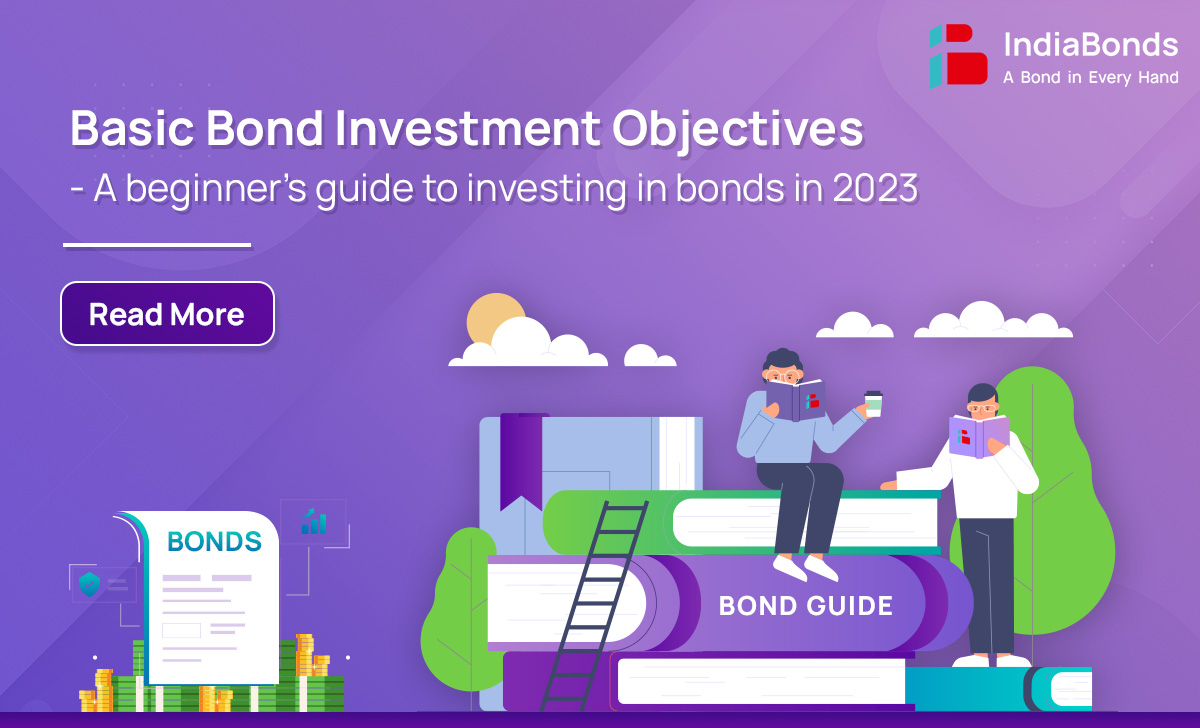Basic Bond Investment Objectives – A beginner’s guide to investing in bonds in 2023

“It’s only when the tide goes out that you learn who has been swimming naked” – WarrenBuffet
The popular quote still holds true in 2023 where the world is watching as a sensational story of a US-based short seller taking on the Indian behemoth comes to light. Every other equity investor is hoping for a positive outcome because if the rumors are true, it may cause an enormous damage to the economy and catastrophic portfolio destruction. Over the past 20 years, the Indian financial ecosystem has seen a significant transformation. A Plethora of investment avenues have opened up. Nonetheless, certain things have not changed – ‘Scams’ and retail investors have suffered the most; their portfolios have experienced a brutal bloodbath. Due to this, investors now are in a pickle and uncertain about where to invest their funds in this situation, particularly those investors who have taken the brunt of these scams and are primarily seeking capital protection.
Bonds are a type of fixed-income investment that can help protect your capital by providing a reliable stream of income and a relatively stable value. When you buy a bond, you are essentially lending money to the issuer, who promises to pay you back with interest at a predetermined rate and time in the future. Because bonds typically have a fixed interest rate and maturity date, they are less risky than other types of investments like equities. This predictability makes them attractive to investors who are looking to preserve their capital and avoid the volatility of other markets. Bonds have existed for a very long period. The first official government bond was issued by the Bank of England in 1694 to raise money to fund a war against France.
Before we get into bond basics, let’s clarify the fundamental misconceptions regarding bonds that exist in the mind of investors:
- In contrast to equity, bonds traditionally are not a speculative asset type and are not primarily meant for trading.
- Bonds serve more as a tool for a gradual, consistent form of capital preservation rather than sporadic wealth creation.
- The main purpose of a bond investment is to obtain returns that are fixed, predictable and inflation adjusted. Therefore, it’s perfect for someone who wishes to beat FD returns while still enjoying its benefits.
- It is appropriate for someone who wants predictable cash flows but does not want to take the risk associated with equity markets.
When it comes to the bond market basics, you’ve probably come across a number of online platforms that teach you about the basics of bond investment. What many people miss or fail to address is the crucial question of why bonds? What is the objective of investing in bonds?
Objectives of Investing in Bonds:
The scope of bonds as an asset class is to primarily provide 3 things:
1. Safety:
One of the primary objectives of bond investment is to preserve the principal investment and protect it from potential losses. Bonds are often considered a safer investment option compared to stocks or other high-risk investments, as they offer a fixed rate of return and a low default risk. This makes them an attractive investment option for conservative investors who prioritize safety over potential high returns.
2. Regular Income:
Another important objective of bond investment is to generate a steady stream of income for the investor. Bonds typically pay interest to investors on a regular basis, providing a reliable source of income that can help to balance out the riskier components of an investment portfolio. The amount of interest paid on a bond can vary depending on a number of factors, including the creditworthiness of the issuer, the duration of the bond, and prevailing market interest rates.
3. Steady Growth:
While bonds are primarily considered a conservative investment option, they can also provide opportunities for growth and capital appreciation. As interest rates change and bond prices fluctuate, there can be opportunities for investors to realize gains on their investments. In addition, bonds can help to diversify an investment portfolio, potentially reducing risk and enhancing overall returns.
It’s worth noting that the objectives of investing in bonds can vary depending on an investor’s individual circumstances, risk tolerance, and investment goals. Some investors may prioritize safety and income over growth, while others may be more focused on generating capital gains. Hence, before investing in bonds, one should see to it that their investment goals align with their bond investment objective.

A beginner’s guide to investing in bonds in 2023:
Understand what bonds are:
Bonds are a type of fixed-income investment that represents a loan made by an investor to a government or a corporation. When you invest in bonds, you’re essentially lending your money to these entities in exchange for interest payments and the return of your principal when the bond matures.
Determine your investment goals:
Before investing in bonds, it’s important to determine your investment goals. Are you looking for a regular income, tax-saving or retirement funds? This will help you determine the types of bonds you should invest in.
Choose the type of bond:
There are different types of bonds available, including government bonds, corporate bonds, municipal bonds, and green bonds. Each type of bond has different risks and potential returns. For example, government bonds are generally considered safer than corporate bonds, but they may offer lower returns.
Evaluate bond ratings:
Bond ratings are issued by rating agencies and they indicate the creditworthiness of the issuer. Higher-rated bonds are generally considered less risky than lower-rated bonds, but they may also offer lower returns.
Consider the yield:
The yield on a bond is the return you can expect to receive on your investment. Higher-yielding bonds may offer greater potential returns, but they also come with higher risks.
Diversify your portfolio:
It’s important to diversify your bond portfolio by investing in different types of bonds from different issuers. This can help reduce the risk of losing money if one issuer defaults. One can also explore duration play and invest based on various interest rate frequencies.
Monitor your investments:
Once you’ve invested in bonds, it’s important to monitor your investments regularly. Keep an eye on the bond ratings, interest rates, and other market trends that could impact your investments.
Start your investment journey with IndiaBonds:
Invest in Bonds with IndiaBonds for a hassle-free and seamless online investment experience all in less than 6 minutes. Simply signup, complete your paperless KYC and invest with ease all from the comfort of your home.
Conclusion
SEBI has taken several initiatives to encourage bond investing in India and also simplified the bond issuance process, making it easier for companies to issue bonds. SEBI has mandated that all large corporates must raise a minimum of 25% of their debt requirements through the bond market. This move has increased the availability of bonds in the market, making it easier for investors to find suitable investment options. Bond investing can be a suitable investment option for investors looking for a relatively stable and predictable stream of income while protecting their capital from market volatility and economic downturns. Sign up on IndiaBonds to learn more about the bond market and register for the upcoming webinars to gain valuable insights regarding bond investments.
FAQs
1. What are the basics of buying bonds?
Buying bonds involves lending money to a company or government entity in exchange for a fixed interest rate and an assurance to return the principal amount at a specified date in the future. The investor purchases the bond at a specific price and the price can fluctuate based on market conditions. Bonds can be purchased through a broker or directly from the issuer, and can be held until maturity or sold in the secondary market. Bonds are considered a relatively low-risk investment option, but investors should carefully evaluate the creditworthiness of the issuer before investing.
2. How can a beginner invest in bonds?
In India, you can start investing in bonds through the following:
• Online bond investment platforms.
• Registered brokers.
• Directly through an exchange.
• RBI’s Retail Direct Scheme, NSE & BSE Apps.
• Debt ETFs.
3. What are the types of bonds?
There are several types of bonds in India, including government bonds, corporate bonds, municipal bonds, tax-free bonds, and Sovereign Gold Bonds. Investors should carefully evaluate the risks and returns associated with each type of bond before investing.
4. What is the biggest risk in bond investing?
The biggest risk in bond investing is the possibility of default by the issuer. This means that the issuer may not be able to make interest payments or repay the principal amount at the time of maturity, which can result in significant losses for the investor. The risk of default is influenced by various factors, such as the creditworthiness of the issuer, prevailing economic conditions, and changes in interest rates. Other risks associated with bond investing include interest rate risk, inflation risk, and market risk, which can also impact the value of the investment.
Disclaimer: Investments in debt securities/ municipal debt securities/ securitised debt instruments are subject to risks including delay and/ or default in payment. Read all the offer related documents carefully.















































